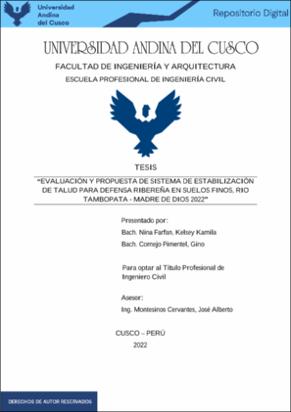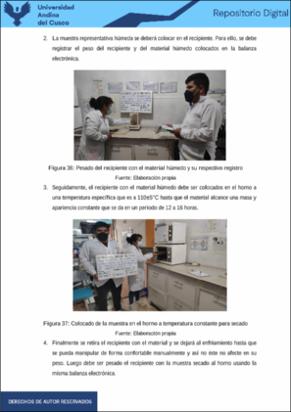| dc.contributor.advisor | Montesinos Cervantes, José Alberto | |
| dc.contributor.author | Nina Farfan, Kelsey Kamila | |
| dc.contributor.author | Cornejo Pimentel, Gino | |
| dc.date.accessioned | 2022-12-23T14:54:25Z | |
| dc.date.available | 2022-12-23T14:54:25Z | |
| dc.date.issued | 2022-10-28 | |
| dc.identifier.uri | https://hdl.handle.net/20.500.12557/5057 | |
| dc.description.abstract | La actual investigación se centra en evaluar y diseñar una propuesta de sistema de estabilización
para defensa ribereña con gaviones del talud del Embarcadero Botafogo – Río Tambopata,
provincia de Tambopata, departamento - Madre de Dios, estableciendo un sistema de gaviones
el Gavión tipo colchón que contrarresta la erosión del suelo y el Gavión tipo caja que estabiliza
el talud. Como estudios preliminares se tuvo la inspección in situ del talud realizando un
levantamiento topográfico que nos proporcionará el perfil de la misma, para determinar las
propiedades físico mecánicas del suelo del talud se auscultaron tres calicatas a lo largo de la
zona de estudio ubicado entre las progresivas km 3+600m a km 3+800m del cual se realizaron
los ensayos Caracterización del material (Contenido de Humedad, Análisis Granulométrico por
tamizado de suelo, Límite Líquido, Límite Plástico e índice de Plasticidad), Clasificación de
suelos método SUCS en la cual se determinó un suelo limo inorgánico con arcilla de baja
plasticidad (ML - CL) carente de grava, el ensayo de Penetración Dinámica Ligera la cual
proporcionó el ángulo de fricción interna de 27.82° como mínimo valor para finalmente obtener
la capacidad portante de qa = 0.84 kg/cm2 requerida para el diseño.
Para el diseño de la propuesta también se desarrolló un estudio hidrológico de la zona, este
estudio consiste en obtener las descargas máximas en función al reporte de precipitaciones
máximas de 24hrs. registradas en las estaciones de Puerto Maldonado, Quincemil y Tambopata
informaciones proporcionado por SENAMHI y por el estudio hidrológico de cuenca del
departamento de Puerto Maldonado. Para determinar los caudales máximos se realizó una
caracterización previa de la cuenca determinando sus parámetros geomorfológicos con la ayuda
del software WMS (Watershed Modeling System), para periodos de retorno de 50 años se
realizó la estimación del caudal de 1541.09 m3/s mediante el método Creager. Para el control
de la erosionabilidad se realizó el cálculo de socavación del talud con el método de Levediev
obteniendo una profundidad de socavación de 4.10 m a través de datos obtenidos en el
modelamiento hidráulico realizado en el software HecRas. Con los datos obtenidos de los
estudios de mecánica de suelos, hidrológico e hidráulico se logra diseñar el gavión tipo caja con
una altura de 1.00m que tiene la función de estabilizar el talud y el gavión tipo Colchón con
una altura de 0.30m que tiene la función de controlar la erosión que produce el río, cada uno
lleno de piedra de peso específico 14.61 kN/m3 y con una altura total de muro de 7.00 m cuya
función será la de mitigar el deslizamiento y socavación que se produce por el incremento del
agua de río Tambopata según el diseño final. | es_PE |
| dc.description.abstract | The current research is focused on evaluating and designing a proposal for a stabilization system
for riparian defense with gabions of the slope of the Botafogo Jetty - Tambopata River,
Tambopata province, department - Madre de Dios, establishing a system of gabions, the
mattress type gabion that counteracts soil erosion and the box type gabion that stabilizes the
slope. As preliminary studies, an in situ inspection of the slope was carried out by performing
a topographic survey that will provide the profile of the slope. To determine the physicalmechanical
properties
of
the
soil
of
the
slope,
three
test
pits
were
excavated
along
the
study
area
located between km 3+600m to km 3+800m, from which the following tests were
performed Characterization of the material (Moisture content, Granulometric Analysis by soil
sieving, Liquid Limit, Plastic Limit and Plasticity Index), Soil Classification SUCS method in
which it was determined an inorganic silt soil with clay of low plasticity (ML - CL) lacking
gravel, the Light Dynamic Penetration test which provided the angle of internal friction of 27.
82° as a minimum value to finally obtain the bearing capacity of qa = 0.84 kg/cm2 required for
the design.
For the design of the proposal, a hydrological study of the area was also developed. This study
consists of obtaining the maximum discharges based on the 24-hour maximum rainfall report
recorded at the Puerto Maldonado, Quincemil and Tambopata stations, information provided
by SENAMHI and by the hydrological study of the basin of the department of Puerto
Maldonado. To determine the maximum flows, the basin was previously characterized by
determining its geomorphological parameters with the help of the WMS (Watershed Modeling
System) software; for a return period of 50 years, the flow was estimated at 1541.09 m3/s using
the Creager method. For erosion control, the slope scour was calculated using the Levediev
method, obtaining a scour depth of 4.10 m through data obtained from the hydraulic modeling
performed in the HecRas software. With the data obtained from the soil mechanics,
hydrological and hydraulic studies, a box gabion with a height of 1.00 m was designed to
stabilize the slope and a mattress gabion with a height of 0.30 m was designed to control the
slope that has the function of controlling the erosion produced by the river, each one filled with
stone of specific weight 14.61 kN/m3 and with a total height of wall of 7.00 m whose function
will be to mitigate the sliding and scour that is produced by the increase of the water of the
Tambopata River according to the final design. | en_US |
| dc.format | application/pdf | es_PE |
| dc.language.iso | spa | es_PE |
| dc.publisher | Universidad Andina del Cusco | es_PE |
| dc.rights | info:eu-repo/semantics/openAccess | es_PE |
| dc.rights.uri | https://creativecommons.org/licenses/by-nc-nd/4.0/ | es_PE |
| dc.subject | Estabilización de suelo | es_PE |
| dc.subject | Talud | es_PE |
| dc.subject | Defensa ribereña | es_PE |
| dc.subject | Suelos finos | es_PE |
| dc.title | Evaluación y propuesta de sistema de estabilización de talud para defensa ribereña en suelos finos, rio Tambopata - Madre de Dios 2022 | es_PE |
| dc.type | info:eu-repo/semantics/bachelorThesis | es_PE |
| thesis.degree.name | Ingeniero Civil | es_PE |
| thesis.degree.grantor | Universidad Andina del Cusco. Facultad de Ingeniería y Arquitectura | es_PE |
| thesis.degree.discipline | Ingeniería Civil | es_PE |
| dc.publisher.country | PE | es_PE |
| dc.subject.ocde | https://purl.org/pe-repo/ocde/ford#2.01.01 | es_PE |
| renati.advisor.dni | 25001820 | |
| renati.advisor.orcid | https://orcid.org/0000-0002-3256-7664 | es_PE |
| renati.author.dni | 62407175 | |
| renati.author.dni | 78202792 | |
| renati.discipline | 732016 | es_PE |
| renati.juror | Roman Villegas, Eigner | |
| renati.juror | Gutierrez Vallejo, Heber Darwin | |
| renati.juror | Ríos Rabelo, José Luis | |
| renati.juror | Bellota Limachi, Cristel Arascelly | |
| renati.level | https://purl.org/pe-repo/renati/level#tituloProfesional | es_PE |
| renati.type | https://purl.org/pe-repo/renati/type#tesis | es_PE |



